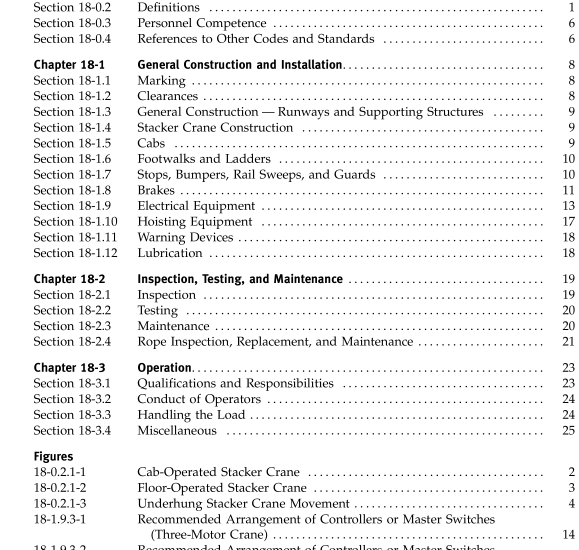ASME B30.18:2016 pdf download Stacker Cranes (Top or Under Running Bridge, Multiple Girder With Top or Under Running Trolley Hoist) Safety Standard for Cableways, Cranes, Derricks, Hoists, Hooks, Jacks, and Slings
drumm: a cylindrical member around which the rope iswound for lifting or lowering the load.
dynamic braking: a method of controlling speed by usingthe motor as a generator, with the energy being dissi-pated in resistors.
eddy current braking: a method of controlling or reducingspeed by means of an electrical induction load brake.ermergeucy brake: a brake for travel motion that is releasedduring normal operation and arranged to apply aretarding force when initiated by the operator duringan emergency or to automatically apply a retarding forceupon loss of power.
emergency braking: a method of decelerating a drive whenpower is not available. The braking effort may be estab-lished as a result of action by the operator or automati-cally when power to the drive is interrupted.
end tie: a structural member that connects the ends ofthe bridge girders to maintain squareness of the bridge.equalizer: a device that compensates for unequal lengthor stretch of a rope.
exposed: applies to hazardous objects not guarded orisolated, and capable of being contacted inadvertently.foofwvalk: a walkway with handrail on or attached to thebridge or trolley for access purposes.
forks: a load-bearing means mounted on the carriage.free fall stop: a mechanism used to prevent or stop down-ward vertical travel of the carriage or cab in the eventof loss of support.
heaoy service: service that involves operating at 85% to100% of rated load or in excess of 10 lift cycles /hr as aregular specified procedure.
hoist: a machinery unit that is used for lifting andlowering.
hoist chain: the chain in a hoist that supports the carriageand is calibrated to mate with sprockets,idlers,andpocket wheels.
hoisting mecharism: the means provided for lifting andlowering portions of the stacker and the rated load.holding brake: a friction brake for a hoist that is automati-cally applied and prevents motion when power to thebrake is off.
home position: the position that is both an originatingpoint and terminating point of the stacker crane cycle.hydraulic braking: a method of controlling or reducingspeed by means of displacement of a liquid.
lisit switch: a device that is operated by some part ormotion of a power-driven machine or equipment to altera circuit associated with the machine or equipment.load cefer: a point on the forks, measured from the heelof the forks, that establishes the limiting distance on the
forks for positioning the center of gravity of the load tobe lifted.
si szsifch: a switch controlling the main power supplyto the equipment.
anwal controller: a controller having all of its basic func-tions performed by devices that are operated by hand.asf: a vertical structure, attached to the trolley, for guid-ing the carriage.
asfer szwifch: a device that dominates the operation ofcontactors and auxiliary devices of an enclosed circuit.mechanical braking: a method of controlling or reducingspeed by friction.
11oncoasting mechanical drie: a drive that automaticallyresults in decelerating a trolley or bridge when poweris not available.
ormal operating condifions (of cab-operated cranes): condi-tions during which the equipment is performing func-tions within the scope of the original design. Underthese conditions, the operator is at the operating controldevices, and there is no other person on the equipment.ornal operating couditions (of floor-operated cranes): condi-tions during which the equipment is performing func-tions within the scope of the original design. Underthese conditions, the operator is at the operating controldevices that are attached to the equipment but operatedwith the operator off the equipment and there is noperson on the equipment.
uormal operating conditions (of remote-aperated cranes): con-ditions during which the equipment is performing func-tions within the scope of the original design. Underthese conditions, the operator is at the operating controldevices that are not attached to any part of the equip-ment and with no other person on the equipment.vormal service: service that averages operating at lessthan 85% of rated load and not more than 10 lift cyclesper hour for isolated instances.
parking brake: a brake for bridges and trolleys that maybe automatically or manually applied in an attempt toprevent horizontal motion by restraining wheel rotation.qualified person: a person, who by possession of a recog-nized degree in an applicable field, certificate of profes-sional standing, or who by extensive knowledge,training, and experience, has successfully demonstratedthe ability to solve or resolve problems relating to thesubject matter and work.
rail szveep: a device attached to the crane and located infront of the crane’s leading wheels to removeobstructions.
rated load (capacify): the maximum load designated bythe manufacturer for which equipment is designedand built.
